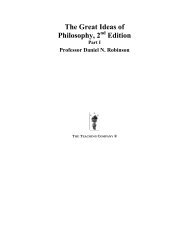English idioms in the first language and second language lexicon: a ...
English idioms in the first language and second language lexicon: a ...
English idioms in the first language and second language lexicon: a ...
You also want an ePaper? Increase the reach of your titles
YUMPU automatically turns print PDFs into web optimized ePapers that Google loves.
352 <strong>English</strong> <strong>idioms</strong> <strong>in</strong> <strong>the</strong> L1 <strong>and</strong> L2 <strong>lexicon</strong>conceptual representations. In Frost, R. <strong>and</strong> Katz, L., editors,Orthography, phonology, morphology, <strong>and</strong> mean<strong>in</strong>g. Amsterdam:North-Holl<strong>and</strong>, 389–412.–––– 2000: On <strong>the</strong> source <strong>and</strong> nature of semantic <strong>and</strong> conceptualknowledge. Bil<strong>in</strong>gualism: Language <strong>and</strong> Cognition 3, 7–9.Duquette, G. 1995: Develop<strong>in</strong>g comprehension <strong>and</strong> <strong>in</strong>teraction skills withidiomatic expressions. In Duquette, G., editor, Second <strong>language</strong>practice: classroom strategies for develop<strong>in</strong>g communicativecompetence. Clevedon, Engl<strong>and</strong>: Multil<strong>in</strong>gual Matters, 35–42.Erv<strong>in</strong>-Tripp, S. 2000: Bil<strong>in</strong>gual m<strong>in</strong>ds. Bil<strong>in</strong>gualism: Language <strong>and</strong>Cognition 3, 10–12.Estill, R.B. <strong>and</strong> Kemper, S. 1982: Interpret<strong>in</strong>g <strong>idioms</strong>. Journal ofPsychol<strong>in</strong>guistic Research 11, 559–68.Everaert, M. 1993: Verbal <strong>idioms</strong>, participant <strong>idioms</strong> <strong>and</strong> <strong>the</strong>ta <strong>the</strong>ory. InSmith, L., editor, Papers from <strong>the</strong> third annual meet<strong>in</strong>g of <strong>the</strong> formalL<strong>in</strong>guistics Society of Midamerica. Bloom<strong>in</strong>gton, IN: IndianaL<strong>in</strong>guistics Club, 43–59.Francis, W.S. 2000: Clarify<strong>in</strong>g <strong>the</strong> cognitive experimental approach tobil<strong>in</strong>gual research. Bil<strong>in</strong>gualism: Language <strong>and</strong> Cognition 3, 13–15.Fraser, B. 1970: Idioms with<strong>in</strong> a transformational grammar. Foundations ofLanguage 6, 22–42.Frauenfelder, U.H. <strong>and</strong> Schreuder, R. 1992: Constra<strong>in</strong><strong>in</strong>g psychol<strong>in</strong>guisticmodels of morphological process<strong>in</strong>g <strong>and</strong> representation: <strong>the</strong> role ofproductivity. In Booij, G. <strong>and</strong> van Marle, J. editors, Yearbook ofmorphology 1991. Dordrecht: Kluwer, 165–83.Gibbs, R.W. 1980: Spill<strong>in</strong>g <strong>the</strong> beans on underst<strong>and</strong><strong>in</strong>g <strong>and</strong> memory for<strong>idioms</strong> <strong>in</strong> conversation. Memory <strong>and</strong> Cognition 8, 149–56.–––– 1985: On <strong>the</strong> process of underst<strong>and</strong><strong>in</strong>g <strong>idioms</strong>. Journal ofPsychol<strong>in</strong>guistic Research 14, 465–72.–––– 1986: Skat<strong>in</strong>g on th<strong>in</strong> ice: literal mean<strong>in</strong>g <strong>and</strong> underst<strong>and</strong><strong>in</strong>g <strong>idioms</strong><strong>in</strong> conversation. Discourse Processes 9, 17–30.–––– 1990: Psychol<strong>in</strong>guistic studies on <strong>the</strong> conceptual basis of idiomaticity.Cognitive L<strong>in</strong>guistics 1, 417–51.–––– 1992:What do <strong>idioms</strong> really mean? Journal of Memory <strong>and</strong> Language31, 485–506.–––– 1995: Idiomaticity <strong>and</strong> human cognition. In Everaert, M., van derL<strong>in</strong>den, E.-J., Schenk, A. <strong>and</strong> Schreuder, R., editors, Idioms: structural<strong>and</strong> psychological perspectives. Hillsdale, NJ: Erlbaum, 97–116.Gibbs, R.W. <strong>and</strong> Nayak, N.P. 1989: Psychol<strong>in</strong>guistic studies on <strong>the</strong> syntacticbehaviour of <strong>idioms</strong>. Cognitive Psychology 21, 100–38.Gibbs, R.W. <strong>and</strong> O’Brien, J. 1990: Idioms <strong>and</strong> mental imagery: <strong>the</strong>metaphorical motivation for idiomatic mean<strong>in</strong>g. Cognition 36, 35–68.Gibbs, R.W., Nayak, N.P. <strong>and</strong> Cutt<strong>in</strong>g, C. 1989: How to kick <strong>the</strong> bucket<strong>and</strong> not decompose: Analyzability <strong>and</strong> idiom process<strong>in</strong>g. Journal ofMemory <strong>and</strong> Language 28, 576–93.Gibbs, R.W., Nayak, N.P., Bolton, J.L. <strong>and</strong> Keppel, M.E. 1989: Speakers’assumptions about <strong>the</strong> lexical flexibility of <strong>idioms</strong>. Memory <strong>and</strong>Cognition 17, 58–68.Downloaded from http://slr.sagepub.com at Shanghai Jiaotong University on March 7, 2009














